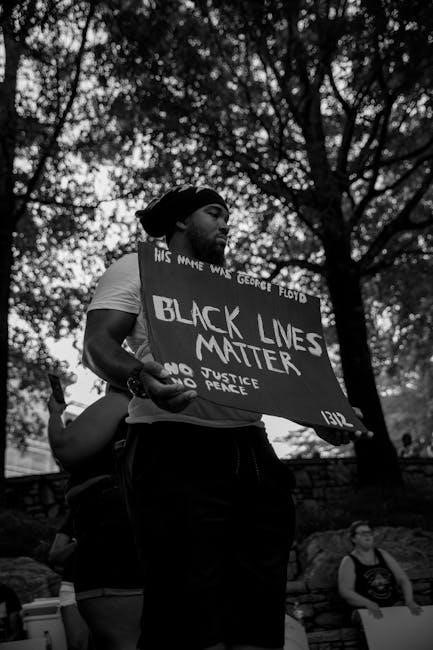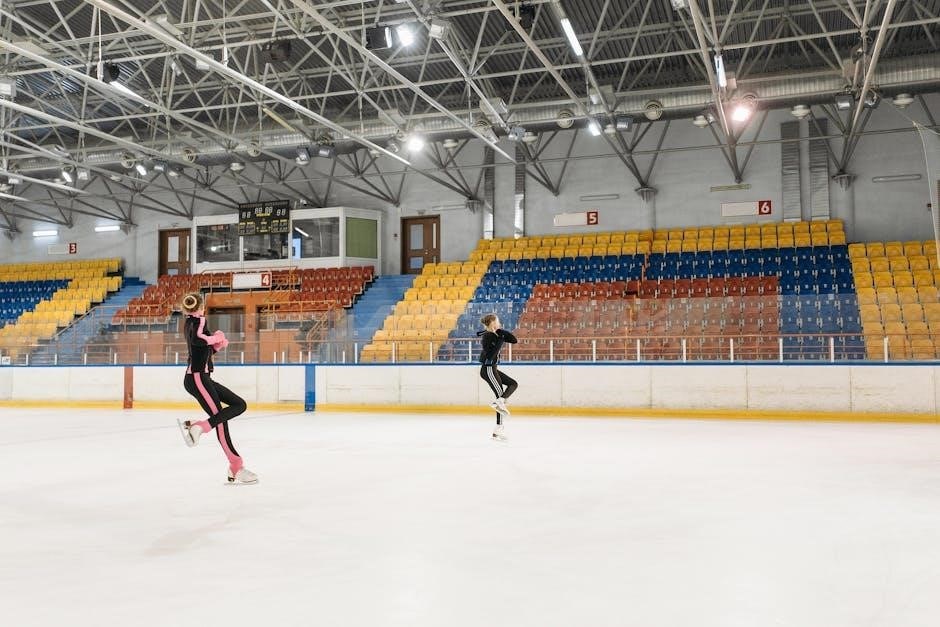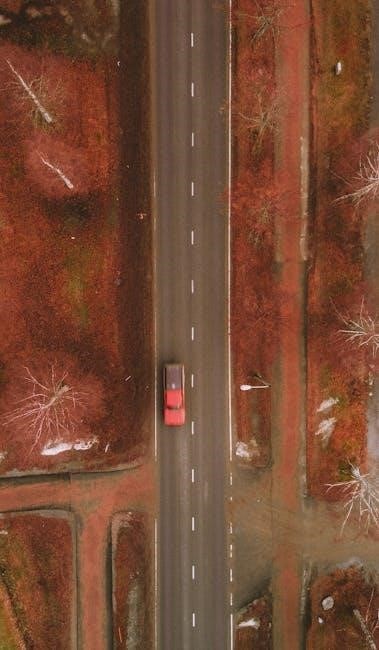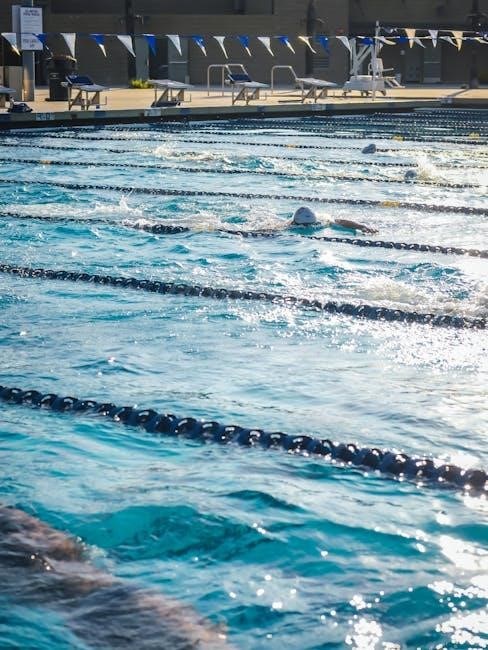
A Motion to Change Venue allows individuals to request transferring their immigration case to a more convenient court. This legal process is governed by 8 CFR 1003.20 and requires submitting Form EOIR-33 along with supporting documents to establish good cause for the change. It is commonly filed due to proximity to counsel‚ witness availability‚ or personal hardship‚ ensuring fairness and efficiency in immigration proceedings.
1.1. Definition of a Motion to Change Venue
A Motion to Change Venue is a formal request to transfer immigration proceedings from one court to another. It is typically filed to move the case to a court closer to the respondent’s residence or for other compelling reasons. The motion must be submitted in writing‚ often using Form EOIR-33‚ and must demonstrate good cause for the change. This legal tool ensures that immigration cases are heard in a more convenient or appropriate location‚ adhering to 8 CFR 1003.20 guidelines.
1.2. Purpose of Filing a Motion to Change Venue
The primary purpose of filing a Motion to Change Venue is to request the transfer of immigration proceedings to a more convenient or appropriate court. This motion aims to ensure that the case is heard in a location that minimizes hardship‚ improves access to legal representation‚ or facilitates the gathering of evidence. By filing this motion‚ respondents can address logistical challenges‚ such as distance from their residence or the availability of witnesses‚ thereby promoting fairness and efficiency in the immigration process.
1.3. Benefits of Changing Venue in Immigration Cases
Changing the venue in immigration cases offers several benefits‚ including enhanced access to legal representation‚ reduced travel costs‚ and the ability to gather evidence more efficiently. It can also alleviate personal hardships‚ such as relocating for court appearances‚ and ensure that proceedings are conducted in a location with greater familiarity or relevance to the case. This can lead to a more efficient and fair resolution of the immigration matter‚ ultimately benefiting both the respondent and the court system.

Template and Form Requirements
The motion requires Form EOIR-33‚ a cover page‚ proposed order‚ and proof of service to DHS‚ ensuring compliance with immigration court procedures and documentation standards.
2.1. EOIR-33 Form for Change of Venue
The EOIR-33 form is mandatory for requesting a change of venue in immigration proceedings. It must be completed accurately and signed by the respondent or their attorney. Separate forms are required for each family member included in the motion. The form requests detailed information‚ including the current and proposed venue‚ the basis for the request‚ and certification of service to DHS. Proper completion ensures the motion is processed efficiently‚ avoiding delays or dismissal due to errors. Additional documentation‚ such as proof of address and hardship evidence‚ may also be required.
2.2. Cover Page and Supporting Documents
A cover page is essential for a Motion to Change Venue package‚ providing a clear title‚ case name‚ and court details. Supporting documents must include the completed EOIR-33 form for each family member‚ proof of the respondent’s new address‚ and a proposed order for the judge’s approval. Additionally‚ evidence such as utility bills‚ leases‚ or affidavits may be submitted to demonstrate hardship or convenience. Properly organizing these documents ensures the motion is complete and ready for court review;
2.3. Proposed Order for Venue Change
A Proposed Order for Venue Change is a critical component of the motion package. It outlines the specific relief requested‚ such as transferring the case to a new court location. The order must be formatted according to court standards and include the case caption‚ respondent’s name‚ and the immigration judge’s section. It should clearly state the new venue and be submitted for the judge’s signature if the motion is granted. Including this document streamlines the process and ensures clarity in the court’s decision-making.
2.4. Proof of Service to DHS
Proof of Service to DHS is a mandatory step in the venue change process. It involves documenting that the motion and supporting documents have been properly served to the Department of Homeland Security. This can be done via certified mail‚ email‚ or other approved methods. A signed and dated acknowledgment from DHS or proof of delivery must be included. Failure to provide this documentation can result in delays or denial of the motion. Timely submission ensures compliance with legal requirements and maintains the integrity of the process.

Legal Standards for Changing Venue
Legal standards for changing venue require demonstrating good cause under 8 CFR 1003.20. This involves showing that transferring the case serves justice‚ convenience‚ or efficiency without prejudicing either party.
3.1. 8 CFR 1003.20 as the Legal Basis
8 CFR 1003.20 is the governing regulation for motions to change venue in immigration proceedings. It allows respondents to request a transfer of their case to a different immigration court‚ provided they establish good cause. The regulation emphasizes that the motion must align with the interests of justice and judicial efficiency. Proper documentation‚ including Form EOIR-33‚ is essential to support the request. The court evaluates each case individually‚ ensuring fairness and convenience for all parties involved while maintaining procedural integrity.
3.2. Establishing Good Cause for Venue Change
To establish good cause for a venue change‚ respondents must demonstrate significant hardship or inconvenience if the case proceeds in the current location. This may include relocation for employment‚ family obligations‚ or access to counsel. Supporting evidence‚ such as proof of residency‚ employment letters‚ or affidavits from witnesses‚ is required. The court evaluates whether transferring the case aligns with the interests of justice and efficiency. Proper documentation‚ including Form EOIR-33‚ is essential to substantiate the request and show how the change benefits both parties.
3.3. Opposition or Consent from DHS
The Department of Homeland Security (DHS) may oppose or consent to a venue change. If DHS does not object‚ the motion is more likely to be granted. However‚ if DHS opposes‚ they must file a response outlining their reasons. The court considers DHS’s position when deciding the motion. Proper service of the motion to DHS is required‚ ensuring they have the opportunity to respond. Their stance significantly influences the court’s decision‚ emphasizing the importance of addressing their concerns in the filing.
Filing and Submission Process
The process involves submitting the motion to the appropriate immigration court. Ensure all required documents are included‚ and the motion is filed timely. Proper service to DHS is mandatory‚ and proof of service must be attached. The court may require additional submissions or responses. Adhering to deadlines and procedures is crucial for the motion to be considered. Always verify the correct filing location and any specific court requirements to avoid delays or dismissal.
4.1. Where to File the Motion
The motion to change venue must be filed with the immigration court where your case is currently pending. Submit the completed Form EOIR-33 and supporting documents to the court’s address listed on your notices. Ensure the filing is done in person or via mail‚ following the court’s specific procedures. The court’s contact information can be found on the EOIR website or by calling 1-800-898-7180. Always verify the correct filing location to ensure proper processing of your request.
4.2. Deadline for Filing the Motion
The motion to change venue must be filed promptly‚ ideally as soon as the need arises. Generally‚ you must submit the Form EOIR-33 and supporting documents within five working days of any change in address or receipt of a Notice to Appear with incorrect contact information. Failing to meet this deadline may result in denial or dismissal of your request. Ensure timely filing to avoid delays in your immigration proceedings. Always verify the court’s specific deadline requirements before submitting your motion.
4.3. Serving the Motion to DHS
Serving the motion to DHS is a critical step in the process. You must provide proof of service‚ ensuring the Department of Homeland Security receives the motion and supporting documents. This typically involves mailing or hand-delivering the documents to the appropriate DHS office‚ such as ICE or CBP. Proper service ensures the court acknowledges your request and prevents dismissal. Always retain a copy of the proof of service for your records and file it with the court to confirm compliance with procedural requirements.

Required Documentation
The required documentation includes a completed EOIR-33 form for each family member‚ proof of a new address‚ and evidence of hardship or convenience supporting the venue change.
5.1. Proof of New Address
Proof of a new address is essential to support a Motion to Change Venue. This can include utility bills‚ rental agreements‚ or bank statements showing the applicant’s name and new location. The documents must be recent‚ typically dated within 30 days‚ to establish current residency. This evidence demonstrates the applicant’s genuine connection to the requested venue‚ ensuring the court can evaluate the motion’s merits based on verifiable residency details.
5.2. Family Members’ EOIR-33 Forms
Each family member included in the motion must complete and sign a separate EOIR-33 form. This ensures all individuals affected by the venue change are accounted for. The forms must be submitted alongside the primary applicant’s motion‚ with documentation proving familial relationships‚ such as birth or marriage certificates. Failure to include all family members’ forms may result in delays or denial of the motion‚ emphasizing the importance of thorough preparation and accuracy in the submission process.
5.3. Evidence of Hardship or Convenience
Evidence of hardship or convenience is crucial to support a motion to change venue. This includes proof of residency‚ employment verification‚ or family obligations demonstrating why the current location imposes a burden. Documentation such as utility bills‚ lease agreements‚ or letters from employers can establish hardship. Convenience may be shown through proximity to legal representation or witnesses. The evidence must clearly illustrate how the current venue causes significant difficulty or inconvenience‚ strengthening the case for a venue transfer to a more accessible location.

Court Considerations
Courts consider the Immigration Judge’s discretion‚ the impact on proceedings‚ and the need for appearances until the motion is resolved when evaluating a venue change.
6.1. Immigration Judge’s Discretion
The Immigration Judge has the authority to grant or deny a motion to change venue based on factors such as convenience‚ hardship‚ and the impact on proceedings. The judge evaluates whether the requested venue change serves the interests of justice and efficiency. If the motion is denied‚ the case remains in the original court. The judge’s decision is final unless appealed‚ ensuring judicial discretion is exercised fairly and consistently in immigration cases.
6.2. Impact of Venue Change on Proceedings
A venue change can significantly impact immigration proceedings by enhancing efficiency and fairness. It may streamline access to witnesses‚ evidence‚ and legal representation‚ ensuring a more balanced case presentation. However‚ transferring a case can also introduce logistical challenges‚ such as delays in scheduling or reallocating court resources. The new venue may affect the availability of key witnesses or evidence‚ potentially influencing the outcome. Proper documentation and timely filing are crucial to minimize disruptions and ensure continuity in the judicial process.
6.3. Appearance Requirements Until Motion is Decided
Until a motion to change venue is decided‚ the respondent must continue to appear at all scheduled hearings and comply with court orders. Failure to appear may result in dismissal or other legal consequences‚ even if the venue change is pending. The court must be kept informed of the respondent’s current address to ensure proper notification of rulings or hearing dates. Maintaining communication with the court and legal counsel is essential to avoid procedural complications during this period.

Sample Motion to Change Venue
A sample Motion to Change Venue provides a template for requesting a transfer of immigration proceedings. It includes Form EOIR-33‚ a cover page‚ proof of address‚ and a proposed order‚ ensuring all requirements are met for submission to the court.
7.1. Structure of the Motion
The structure of a Motion to Change Venue typically includes a clear heading‚ respondent’s information‚ and a concise statement of the request. It begins with a cover page outlining the purpose‚ followed by the completed EOIR-33 form for each family member. The motion should detail the reasons for the venue change‚ supported by evidence like a new address proof. A proposed order and proof of service to DHS are also essential components‚ ensuring compliance with legal standards and procedures.
7.2. Language and Tone in the Motion
The language and tone in a Motion to Change Venue must be formal‚ clear‚ and respectful. The motion should be well-organized‚ with a logical presentation of facts and reasons for the request. Avoid slang‚ emotional language‚ or informal expressions. Use precise legal terminology and ensure all statements are factual and supported by evidence. The tone should convey professionalism and respect for the court‚ while persuasively advocating for the venue change based on established legal standards and personal circumstances.
7.3. Attachments and Exhibits
Attachments and exhibits are crucial for supporting a Motion to Change Venue. Include a completed Form EOIR-33 for each family member‚ proof of the new address‚ and evidence of hardship or convenience. Attach a proposed order for the court’s approval and ensure all documents are clearly labeled. Proof of service to DHS must also be included to confirm proper notification. Exhibits should be organized and relevant‚ avoiding unnecessary documentation to maintain clarity and focus on the key reasons for the venue change request.

Common Reasons for Filing a Motion
Common reasons for filing a Motion to Change Venue include proximity to counsel‚ witness availability‚ and personal hardship. These factors ensure fairness and efficiency in immigration proceedings.
8.1. Proximity to Counsel
Proximity to counsel is a significant reason for filing a Motion to Change Venue. Having legal representation nearby ensures effective communication‚ case preparation‚ and court appearances. When an individual’s attorney is located far from the current venue‚ it can hinder proper representation and case management. By transferring the case to a court closer to the attorney‚ the respondent can maintain consistent legal advice and ensure their rights are adequately protected throughout the immigration proceedings‚ promoting fairness and efficiency in the process.
8.2. Witness Availability
Witness availability is a common reason for filing a Motion to Change Venue. If key witnesses are located near a different court‚ transferring the case ensures their testimony can be easily obtained. Inconvenient locations may deter witnesses from appearing‚ potentially weakening the case. By moving the venue closer to where witnesses reside‚ respondents can secure necessary testimony‚ ensuring their case is presented effectively. This consideration is crucial for building a strong defense and achieving a fair outcome in immigration proceedings.
8.3. Personal Hardship

Personal hardship is a significant reason for filing a Motion to Change Venue. Financial strain‚ family obligations‚ or health issues can make it difficult to attend proceedings in the current location. A venue change may alleviate these challenges‚ ensuring respondents can participate effectively. Documentation‚ such as evidence of hardship or letters explaining the situation‚ is often required to demonstrate good cause under 8 CFR 1003.20. This consideration aims to balance fairness and practicality in immigration proceedings‚ ensuring respondents’ needs are addressed.
Denial of Motion to Change Venue
A Motion to Change Venue may be denied if the court finds insufficient evidence of good cause‚ such as lack of hardship or convenience. Under 8 CFR 1003.20‚ denial means proceedings remain in the original court. Respondents must still appear for scheduled hearings‚ ensuring compliance with immigration court requirements despite the denial of their request.
9.1. Grounds for Denial
The court may deny a Motion to Change Venue if it finds insufficient evidence of good cause‚ such as lack of hardship‚ inconvenience‚ or no clear benefit to the case. Additionally‚ if the request is deemed untimely or fails to comply with procedural requirements like submitting Form EOIR-33 or providing proper proof of service‚ denial may occur. The court also considers whether the transfer would disrupt proceedings or if the original venue remains appropriate for judicial efficiency and fairness.
9.2. Consequences of Denial
If a Motion to Change Venue is denied‚ the case will remain in the original court‚ potentially causing significant inconvenience to the respondent. This may result in increased travel expenses‚ logistical challenges for attending hearings‚ and difficulty accessing legal representation. A denial can also impact the respondent’s ability to present their case effectively‚ especially if witnesses or evidence are located in the requested venue. The court’s decision emphasizes the importance of meeting procedural and substantive requirements when filing the motion to avoid adverse outcomes.
9;3. Appeal Process
If a Motion to Change Venue is denied‚ the respondent can appeal the decision to the Board of Immigration Appeals (BIA). The appeal must be filed within 30 days of the denial‚ detailing why the immigration court erred in its decision. The appellant must demonstrate that the denial was an abuse of discretion or based on legal error. A properly drafted appeal is crucial‚ as the BIA will review the record for factual and legal support. Consulting an attorney is highly recommended to strengthen the appeal’s chances of success.
State-Specific Motions
States like Idaho‚ Wisconsin‚ and New York have specific requirements for filing motions to change venue. Each state may have unique legal standards or additional documentation needs‚ ensuring localized compliance and fairness in immigration proceedings.
10.1. Wisconsin Motion to Change Venue
In Wisconsin‚ motions to change venue must adhere to Wisconsin Statutes 801.51-801.53 and 799.11. The process involves filing a motion with the court‚ often including Form GF-122. Recent cases‚ such as in Chippewa County‚ highlight the importance of proper documentation and legal standards. The court evaluates factors like convenience and fairness‚ ensuring the request aligns with local judicial procedures. This state-specific approach ensures compliance with regional legal requirements while addressing the unique circumstances of each case.
10.2. Idaho Motion to Change Venue
In Idaho‚ motions to change venue are governed by specific legal standards and procedures. Notably‚ high-profile cases like the University of Idaho murders have drawn attention to venue change requests. The state has seen instances where such motions are denied‚ citing insufficient grounds. The process typically involves submitting a formal request and supporting documents‚ with the court evaluating factors such as jurisdiction and fairness. This ensures that each motion is thoroughly reviewed in accordance with Idaho’s legal framework.
10.3. New York Motion to Change Venue
New York’s motion to change venue process is well-documented‚ with cases like Donald Trump’s hush money trial highlighting its application. The state’s courts require thorough documentation‚ including Form EOIR-33 and proof of address‚ to establish good cause; A recent appeals court denial of Trump’s venue change request underscores the rigorous standards applied. This ensures that each motion is evaluated based on legal merit and fairness‚ maintaining the integrity of New York’s judicial system.

Recent Cases and Examples
Recent high-profile cases‚ such as Idaho’s denial of Bryan Kohberger’s venue change request‚ highlight the challenges and rigorous standards of the motion process‚ emphasizing the importance of proper documentation and legal merit.
11.1. High-Profile Venue Change Requests
High-profile cases often draw significant attention to venue change requests. For instance‚ Bryan Kohberger’s defense team sought to move his trial due to extensive media coverage‚ arguing it could prejudice the jury. Similarly‚ Donald Trump’s legal team attempted to change the venue of his hush money trial‚ citing concerns about impartiality. These cases underscore the strategic use of venue changes in high-stakes legal battles‚ aiming to ensure a fair trial and mitigate potential biases.
11.2. Successful Motion Outcomes
Successful motions to change venue often hinge on demonstrating clear convenience or hardship. For example‚ a respondent’s motion was granted after showing proximity to counsel and witness availability. Proper documentation‚ such as Form EOIR-33 and proof of address‚ is crucial. Courts prioritize fairness and efficiency‚ approving changes when justified. High-profile cases‚ like Carson Peters-Berger’s‚ highlight the importance of strategic filing. These outcomes emphasize the impact of well-prepared motions and the court’s discretion in balancing interests. Proper documentation and compelling reasons are key to securing favorable rulings.
11.3. Denied Motion Examples
Some motions to change venue are denied due to insufficient evidence of hardship or convenience. For instance‚ in Idaho‚ the court rejected a request citing that defendant convenience is not a mandated reason under Rule 18. Similarly‚ in Wisconsin‚ a defense team withdrew their motion after failing to show compelling reasons. Courts prioritize legal standards over mere preferences‚ often denying motions lacking substantial justification. These cases underscore the importance of meeting the legal burden for venue changes‚ ensuring motions are not granted lightly without clear justification.
Filing a Motion to Change Venue is a critical step in immigration proceedings‚ requiring adherence to legal standards and proper documentation. It balances fairness and judicial efficiency‚ ensuring cases are heard in appropriate settings while maintaining procedural integrity.
12.1. Final Thoughts on Motion to Change Venue
A Motion to Change Venue is a crucial tool for ensuring immigration proceedings are conducted fairly and efficiently. By allowing cases to be transferred to more convenient courts‚ it balances the needs of all parties involved. Proper documentation‚ including Form EOIR-33 and evidence of good cause‚ is essential for success. This process highlights the importance of procedural fairness and the need for courts to adapt to individual circumstances‚ ultimately fostering a more just immigration system.
12.2. Importance of Proper Documentation

Proper documentation is critical when filing a Motion to Change Venue. Submitting a complete package‚ including Form EOIR-33‚ a cover page‚ proof of address‚ and proof of service to DHS‚ ensures the request is reviewed efficiently. Each family member must have their own EOIR-33 form. The cover page should clearly state the reasons for the venue change. Complete and accurate documentation demonstrates compliance with legal standards and increases the likelihood of a favorable decision‚ avoiding delays or denials due to incomplete filings.
12.3. Future of Venue Change Requests
The future of Motion to Change Venue requests may involve increased use of digital platforms for filing and tracking cases. Electronic submission systems‚ like the one mentioned at https://acis.eoir.justice.gov/en/‚ could streamline the process‚ reducing delays. Courts may also adopt stricter standards for documenting “good cause‚” ensuring requests are thoroughly justified; As immigration policies evolve‚ the efficiency and transparency of venue change processes are expected to improve‚ providing clearer guidelines for applicants and reducing disparities in court decisions across jurisdictions.